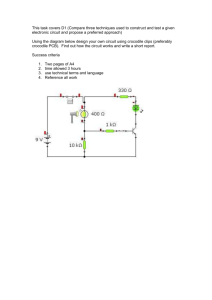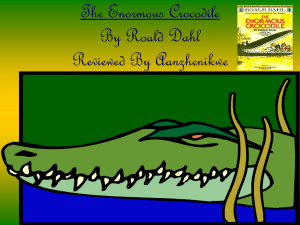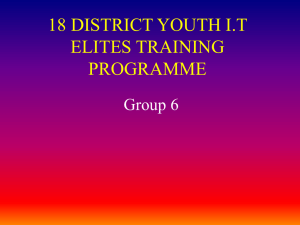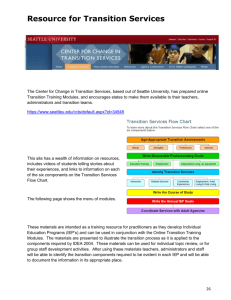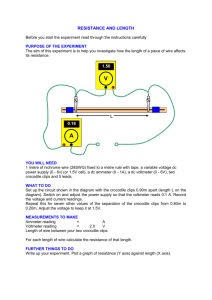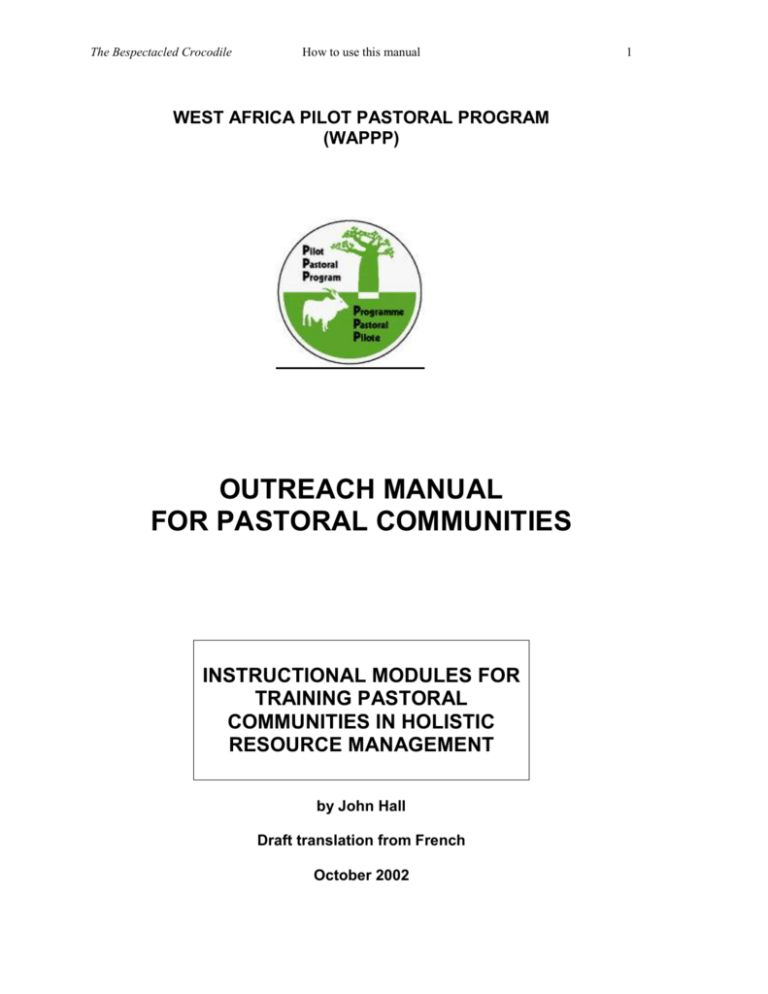
The Bespectacled Crocodile
How to use this manual
WEST AFRICA PILOT PASTORAL PROGRAM
(WAPPP)
OUTREACH MANUAL
FOR PASTORAL COMMUNITIES
INSTRUCTIONAL MODULES FOR
TRAINING PASTORAL
COMMUNITIES IN HOLISTIC
RESOURCE MANAGEMENT
by John Hall
Draft translation from French
October 2002
1
The Bespectacled Crocodile
How to use this manual
2
“THE CROCODILE DOES NOT
NEED TO BE SHOWN HOW TO
FIND THE MARSH”
(Woloff proverb)
The Bespectacled Crocodile
by John Hall
Instructional modules for training pastoral communities in Holistic Management
Some rights reserved. You may copy and distribute this manual or parts of it if you (1) credit the original
authors, (2) include this notice, including the copyright license information below, and (3) on partial copies,
include the following link where people may download the complete manual. English and French versions
are available at
http://managingwholes.com/crocodile/
You may create and distribute derivative works, adaptations, and translations under the same conditions. If
possible, please make an electronic copy available for public distribution (you can do this through
ManagingWholes.com), and send the URL to the author:
crocodile@managingwholes.com
If you wish to use this manual for commercial purposes, please contact the author.
Creative Commons license:
http://creativecommons.org/licenses/by-nc-sa/1.0/
In other words, it would be absurd to presume to teach livestock herding to a herder. As for the
eyeglasses, they allow the crocodile (or the herder) to « see » his environment more clearly and to make
better decisions using the holistic model and the results of monitoring. This is why the image was chosen .
The Bespectacled Crocodile
How to use this manual
3
TABLE OF CONTENTS
Page
How to use this manual
5
Community outreach
13
1.
2.
3.
4.
Trust building
The whole to be managed
Community organization
Conflict prevention
The holistic goal
5. Quality of life
6. Production
7. Landscape
The ecosystem's building blocks
8. Water cycle
9. Nutrient cycle
10. Energy flow
11. Ecological succession
Management tools
12. Animal impact
13. Grazing and rest
14. Time
15. Fire
16. Technologies
Testing guidelines
17. The weak link
18. Cause and effect
19. Ecosystem as a whole
20. Additional resources
21. External dependency and sustainability
22. Society and culture
23. Synthesis of tests
15
20
26
33
41
42
47
51
57
58
63
68
71
77
78
82
87
92
94
99
101
107
111
115
119
123
128
The Bespectacled Crocodile
How to use this manual
Management principles
24. Plants to be promoted
25. minimum resting time (mRT)
26. Maximum grazing time (MGT)
27. Overgrazing
28. mRT, MGT and division into paddocks
Planning of grazing
29. Range-land mapping
30. Relative value of paddocks
31. Events and constraints
32. Finalization of the grazing plan
Herd management
33. Number of animals
34. Moving herds between paddocks
35. Supervising the herd
Monitoring and re-planning
4
134
135
140
145
150
155
162
163
170
176
180
187
188
193
198
205
36. Participatory monitoring: choice of indicators
37. Participatory monitoring: collection and analysis of results
38. Re-planning
206
213
220
1.
2.
3.
4.
5.
6.
225
229
238
256
259
261
Annexes
Holistic management in pictures
Instructional format of the modules
Graphic support material for the modules
Monitoring indicators
Basic vocabulary
Suggested implementation scenarios
The Bespectacled Crocodile
How to use this manual
5
HOW TO USE THIS MANUAL
INTRODUCTION
Background
When it was first introduced in 1994, the West Africa Pilot Pastoral Program
WAPPP; (in french Programme pastoral pilote Ouest Africain, PPPOA) was
intended, by virtue of its experimental nature, to test the validity of the holistic
model of resource management in the Sahel. In this context, the program’s training
component consisted originally, on the one hand, of extension activities directed at
herders during field missions of both national staff and expatriate consultants and, on
the other hand, periodic training sessions for the program’s outreach staff. This
approach assumed that, in this way, skills would be progressively transmitted to the
rural communities concerned. Experience showed, however, that with few
exceptions, communities were still far from having a sufficiently firm grasp of the
holistic model to be able to manage their resources sustainably by the end of the
pilot program.
Preparation of the manual
Starting in 1997, contact was made with specialists in the kind of participatory adult
education developed over the past twenty years in various sectors and disseminated
in particular by the World Bank’s Economic Development Institute (EDI). The 5th
Sub-Regional WAPPP Workshop held in July 1998 in Saint-Louis (Senegal)
provided an opportunity to lend more depth to this approach and persuaded network
members of its validity in terms of strengthening the WAPPP in the sub-region.
This approach to strengthening the WAPPP, which resulted in the preparation of this
manual and its accompanying graphic materials, was developed by a team of about a
half-dozen people (listed below) in the course of two missions, each lasting three
weeks: one to Saint Louis (Senegal) in August 2000, and the other to N’djamena
(Chad) in November 2000.
Preliminary nature of the manual
Most of the 38 training modules contained in this manual were tested with volunteer
agro-pastoral communities while they were being formulated. Although these
communities were not involved in any program and only participated in scattered
sessions rather than in the full outreach cycle, the results were striking, and
demonstrated, if such demonstration were needed, that the approach is appropriate
for this type of target group and for the dissemination of this type of skills.
The Bespectacled Crocodile
How to use this manual
6
These encouraging results should not obscure the preliminary nature of this manual,
however. A training tool such as this one, and the graphic material upon which it is
based, cannot be adapted to all target groups and all situations. Adjustments will be
necessary, and arrangements should be made for the users of this tool to remain in
contact so that they may, in future, come to a joint agreement on the necessary
changes.
Indicators of success
Each training module has been subjected to a detailed pedagogic analysis yielding
precise and verifiable (if not measurable) objectives that are indicators of the results
of the individual modules.
That said, the efficacy of this training tool as a skills development program can only
be judged by the relevant community itself after having participated in the complete
cycle.
For the outside observer, the indicator of success will be the community’s
establishment, or failure to establish, an initial resource management plan that it then
implements, monitors and, on its own initiative, modifies as required.
OUTREACH TEAM
Adult training specialist
Caution! This manual is not a treatise on adult training! It is a tool for adult training
specialists who have some basic background in communications and pedagogy, as
well as for those possessing in-depth and long-term training experience, and finally,
those familiar with the participatory or “experiential” approach to training. This
means that the trainer agrees to function as a facilitator of the learning process,
instead of seeking to convey his own “knowledge” to the target group.
We believe that the efficacy of the training tool proposed here will be seriously
compromised if it is used by "unqualified" people. By “unqualified”, we mean
people lacking instruction in, or experience with, adult training. This also refers to
those who, although they may possess these credentials and experience, are in fact
conventional educators who tend to deliver lectures instead of facilitating the
learning process.
Instructional set-up using a co-facilitator
The facilitator of the training sessions based on this manual must necessarily be
fluent in the language of the participating community. Facilitation of the
experiential process demands, on the part of the facilitator, an ability to perceive the
slightest hesitations, frustrations or desires for self-expression on the part of
The Bespectacled Crocodile
How to use this manual
7
participants, and this is something virtually impossible to accomplish through
interpreters.
In cases where there is no adult training specialist available who is fluent in the
language of the target group, a set-up may be envisaged (and has been tested with
some success) using a co-facilitator who does not have experience in training, but
who is both known to the group concerned and fluent in its language.
Moreover, it is entirely possible that, as this training program develops, a growing
number of co-facilitators will emerge from the corps of outreach personnel, NGOs,
and even schooled auxiliaries from communities themselves. However, the process
will always need to be supervised attentively by the training specialist, who will
provide the needed support.
Resource person
Even if this training does not purport to “show the crocodile where the marsh is”, the
holistic model is a complex and exhaustive construct that is not expected to be
completely mastered by either the training specialist or his/her assistant.
It is therefore imperative that the training team include a pastoralist skilled in holistic
management, who will intervene as needed to provide the necessary clarifications
and more detail on certain technical aspects of the modules. This person does not
necessarily need to be fluent in the language of the target group.
Community "Secretary"
The facilitator will gauge the degree of literacy of the group undergoing the training
cycle: this group may be totally illiterate, but it may also be partially literate, in that
some of its members know the rudiments of Arabic script or can transcribe the local
language phonetically. The use of wristwatches has also familiarized most herders
with reading and writing ‘Arabic” numerals. This can prove to be particularly
helpful during the implementation of the modules dealing with participatory
monitoring.
In all case, it is advisable to have available at every session at least one community
member who can read and write both English and the local language, to serve as
“secretary”. In the Sahelian countries, this role is often assumed by the headmaster
of the village Koranic school.
IMPLEMENTATING THE TRAINING CYCLE
Implementation scenarios
Testing of most of the modules contained in this manual has shown that each one
requires, on average, about an hour to complete. The entire cycle, therefore, can take
about 40 hours,
The Bespectacled Crocodile
How to use this manual
8
Annex # 6 of this manual suggests three possible implementation scenarios: one in
which the 40 hours of training occur in a single week (i.e., the intensive option), one
in which the hours are spread out over three weeks (the intermediate option), or one
lasting seven weeks (the extended option).
The choice of implementation scenario is important, since it will to a great extent
determine the effectiveness of a training cycle that can be costly in terms of time and
resources. This decision should be made jointly by the agency in charge (on the basis
of logistical factors), the facilitator (who will weigh the pedagogical aspects) and,
most importantly, by the community concerned (since it determines the availability
of the target group).
Sequence of the modules
The 38 modules contained in this manual are arranged in a sequence of nine
“instructional units”. This structural arrangement received much attention and was
adjusted numerous times (see instructional format in Annex 2). The holistic model
consists of a sequence of steps that needs to be respected, and from the pedagogical
standpoint, certain modules cannot be covered until certain notions have already
been covered and assimilated.
As a result, it is recommended that the proposed sequence be carefully followed,
with a single exception: module # 4 "Conflict prevention ", which is in the first
instructional unit (i.e., community outreach), should preferably be dealt with at the
very end of the training cycle, as a conclusion to it.
Using the “icons”
The reader will notice the careful attention paid to the graphic representation of the
training itself, the instructional units and training modules. While the symbolism and
graphic quality of these icons can always be improved in the future, it is important to
note that the pictorial representation of each stage of the learning process is
essential.
Indeed, given the large number of modules to be presented over a variable time
period, there is a risk that the cycle will be fragmented, in participants’ minds, into a
multitude of mini-sessions, and that the model’s iterative impact will be diminished.
This is why “icons” will be used throughout: (a) at the beginning and at the end of
each intructional unit; (b) at the end of each training session, when the “icons” of the
new modules will be displayed, alongside those previously covered, on a bulletin
board or wall for the duration of the cycle; and (c) in a three-page “illustrated
holistic model” to be distributed to all participants (Annex # 1).
Reference to modules and images
The Bespectacled Crocodile
How to use this manual
9
The numbering of the modules will be extremely useful for the outreach team, this is
why a module’s number is indicated each time it is mentioned in the manual.
However, one needs to avoid using that number in communicating with participants;
modules should be referred to solely by name and by means of their corresponding
icons.
During testing, it became apparent that, given their large number, images needed to
be numbered individually. Thus, the first two digits (or the first one in the case of the
first nine modules) refer to the module to which the image belongs. The following
two digits constitute the ordinal number of the image within the module.
LOGISTICAL CONSIDERATIONS
Utilization of the flip-chart
Experience during the testing has proved that a standard flip-chart needs to be used
for the entire duration of the training cycle.
The flip chart may be used on its stand when a map is being drawn, or without a
stand (but close to the mat on which the group is seated) when images are being
displayed during a discussion, or even placed flat on the mat for certain exercises
(e.g., determining the relative value of parcels).
Graphic supports
The images accompanying each module in this manual are essential to the training’s
effectiveness.
See the annex on page 238 for an index of images and according to the “folders”
mentioned in the text. For access to the images, please see
http://managingwholes.com/crocodile/ or contact the author for copies.
It cannot be stressed enough that these supports need to be carefully stored in their
corresponding folders.
Before beginning any training session, the facilitator shall make sure that he has all
the necessary graphic supports on hand. In the midst of an exercise, rummaging
around in folders in search of an image disrupts the flow and concentration of the
participants, so be prepared.
Certain documents, and particularly the stickers used to create the village lands map,
management plan and calendar, should be left with the community once the training
cycle has ended. Prior arrangements should be made to have adequate supplies of
these.
The Bespectacled Crocodile
How to use this manual
10
Vocabulary in local languages
Annex # 5 contains around fifty words commonly used in holistic
management.which are key to the implementation of the training sessions. It is
essential that the facilitator confer with the community before starting the training
cycle, in order to establish the best possible translation of each term. The list of
terms can be corrected and completed at the end of the cycle.
ACKNOWLEDGMENTS
The following people were involved in creating the manual and its accompanying
illustrations.
National WAPPP team for Senegal:
Malik Faye, national coordinator
Boubacar N'Diaye, trainer
Algor Thiam, facilitator for Asré Bani site
Assane Dione, graphic artist
National WAPPP team for Chad:
Ahmed Nadif, national coordinator
Lucien M'Beurnodji, trainer
M'Baitoudji Yalngar, facilitator for Fadjé Djékiné site
Darnace Ramdan, graphic artist
Expatriate consultants
Barbara Howald, adult training specialist
Farhat Ben Salem, resource management specialist
John M. Hall, coordinator, editor
The concept of holistic management
The technical substance of this manual is based upon the work of Allan Savory,
founder of the Allan Savory Center for Holistic Management
<www.holisticmanagement.org>. Although this manual has been developped with
the agreement of the Center, the Center is not responsible for its content. For more
information, refer to:
Allan Savory, Holistic management, A new framework for decision making; Island
Press, 1999, 616 pages.
The concept of participatory training
References in the text to participatory exercises send the reader to the following
publication:
The Bespectacled Crocodile
How to use this manual
11
Lyra Srinavasan, Tools for community participation: a manual for training trainers
in participatory techniques. PROWESS/UNDP-World Bank Water and sanitation
program. 1990, 179 pages.

